| Home |
| Acknowledgments |
| Conventions |
| Glossary |
| Maps |
| References |
| Links |
| Articles |
| Thumbnails |
| Species
list |
| Family |
| Next
species |
Additional Photos
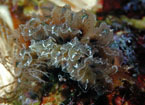
2nd shot

side, pale
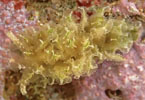
green patches
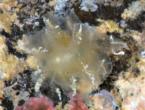
young

pair
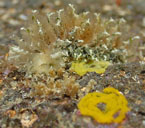
with egg masses?

Polybranchia samanthae Madrano, Krug, Gosliner, Kumar & Valdes, 2018
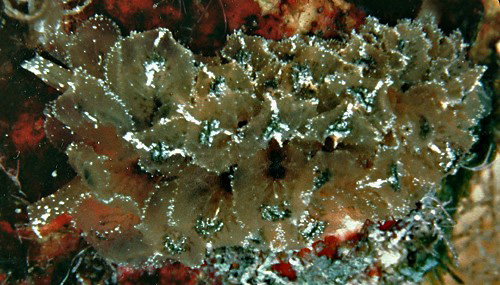
| Maximum size: about 50 mm (rough estimate from photo). Identification: This species has broad, thin, leaf-like cerata with serrated edges. The cerata are finely papillate and often edged with white flecks. A short, opaque-white line extends from the tip to the center of each ceras's inner face where it surrounds a variably-developed, irregular green patch. White pigment is also present on the rhinophore tips, head and pericardium. The cerata usually have more acute tips than in Polybranchia jensenae. Natural history: Polybranchia samanthae is a moderately rare species found in the low intertidal to 6 m (20 ft). It occurs in protected to moderately exposed rocky habitats. It's nocturnal but can be found under rocks during the day. When disturbed, it can autotomize its central cerata. (Note 1) It may lay a yellow egg mass. Distribution: Big Island, Maui, Oahu and Kauai: widely distributed in the Indo-Pacific. Taxonomic notes: Members of this genus were first described from Hawaii by Pease in 1860 under the name Polybranchia pellucida. Later, Kay (1979) used the name Branchophyllum pellucida. However, Medrano, et. al. (2018) states that their descriptions are insufficient to distinguish between Polybranchia jensenae and P. samanthae. So, one or both were probably first reported from Hawaii in Pease, 1860 or Kay, 1979. One or the other may also have been the animal referenced in the text at the bottom of page 185 in Edmondson, 1946. Photo: PF: about 50 mm (rough estimate from photo): found by CP; Hekili Point, Maui; Sept. 1990. Observations and comments: Note 1: Two animals found in 1985 and 1988 autotomized their central cerata abruptly when touched with a bare finger. In one case, the cerata were observed to exude a rubber glue-like mucus and twitch for at least half an hour after being dropped, presumably serving to distract or entangle a potential predator. Two other animals that were handled with probes or spoons didn't autotomize their cerata suggesting that they can discriminate between casual contact and a potential threat. Branches of the digestive gland appear to be concentrated in the lateral cerata that aren't autotomized. Specimens of Polybranchia jensenae seem to be less sensitive, seldom autotomizing their cerata during gentle handling. |
| Thumbnails |
Species
list |
Family | Next species | Top |